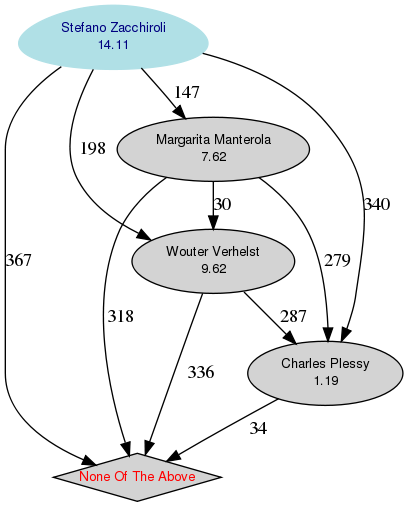Debian Project Leader Elections 2010
Time Line
| Nomination period: | Friday, March 5th 00:00:00 UTC, 2010 | Thursday, March 11th 23:59:59 UTC, 2010 |
|---|---|---|
| Campaigning period: | Friday, March 12th 00:00:00 UTC, 2010 | Thursday, April 1st 23:59:59 UTC, 2010 |
| Voting period: | Friday, April 2nd, 00:00:00 UTC, 2010 | Thursday, April 15th, 23:59:59 UTC, 2010 |
Please note that the new term for the project leader shall start on April 17th, 2010.
Nominations
- Stefano Zacchiroli [[email protected]] [nomination mail] [platform]
- Wouter Verhelst [[email protected]] [nomination mail] [platform]
- Charles Plessy [[email protected]] [nomination mail] [platform]
- Margarita Manterola [[email protected]] [nomination mail] [platform]
Data and Statistics
This year, like always, statistics will be gathered about ballots received and acknowledgements sent periodically during the voting period. Additionally, the list of voters will be recorded. Also, the tally sheet will also be made available to be viewed. Please remember that the project leader election has a secret ballot, so the tally sheet will be produced with the hash of the alias of the voter rather than the name; the alias shall be sent to the corresponding voter along with the acknowledgement of the ballot so that people may verify that their votes were correctly tabulated. While the voting is open the tally will be a dummy one; after the vote, the final tally sheet will be put in place. Please note that for secret ballots the md5sum on the dummy tally sheet is randomly generated, as otherwise the dummy tally sheet would leak information relating the md5 hash and the voter.
Quorum
With the current list of voting developers, we have:
Current Developer Count = 886
Q ( sqrt(#devel) / 2 ) = 14.8828760661372
K min(5, Q ) = 5
Quorum (3 x Q ) = 44.6486281984117
Quorum
- Option1 Reached quorum: 395 > 44.6486281984117
- Option2 Reached quorum: 375 > 44.6486281984117
- Option3 Reached quorum: 217 > 44.6486281984117
- Option4 Reached quorum: 366 > 44.6486281984117
Majority Requirement
All candidates would need a simple majority to be eligible.
Majority
- Option1 passes Majority. 14.107 (395/28) >= 1
- Option2 passes Majority. 9.615 (375/39) >= 1
- Option3 passes Majority. 1.186 (217/183) >= 1
- Option4 passes Majority. 7.625 (366/48) >= 1
Outcome
In the graph above, any pink colored nodes imply that the option did not pass majority, the Blue is the winner. The Octagon is used for the options that did not beat the default.
- Option 1 "Stefano Zacchiroli"
- Option 2 "Wouter Verhelst"
- Option 3 "Charles Plessy"
- Option 4 "Margarita Manterola"
- Option 5 "None Of The Above"
In the following table, tally[row x][col y] represents the votes that option x received over option y. A more detailed explanation of the beat matrix may help in understanding the table. For understanding the Condorcet method, the Wikipedia entry is fairly informative.
| Option | |||||
|---|---|---|---|---|---|
| 1 | 2 | 3 | 4 | 5 | |
| Option 1 | 300 | 373 | 271 | 395 | |
| Option 2 | 102 | 334 | 177 | 375 | |
| Option 3 | 33 | 47 | 53 | 217 | |
| Option 4 | 124 | 207 | 332 | 366 | |
| Option 5 | 28 | 39 | 183 | 48 | |
Looking at row 2, column 1, Wouter Verhelst
received 102 votes over Stefano Zacchiroli
Looking at row 1, column 2, Stefano Zacchiroli
received 300 votes over Wouter Verhelst.
Pair-wise defeats
- Option 1 defeats Option 2 by ( 300 - 102) = 198 votes.
- Option 1 defeats Option 3 by ( 373 - 33) = 340 votes.
- Option 1 defeats Option 4 by ( 271 - 124) = 147 votes.
- Option 1 defeats Option 5 by ( 395 - 28) = 367 votes.
- Option 2 defeats Option 3 by ( 334 - 47) = 287 votes.
- Option 4 defeats Option 2 by ( 207 - 177) = 30 votes.
- Option 2 defeats Option 5 by ( 375 - 39) = 336 votes.
- Option 4 defeats Option 3 by ( 332 - 53) = 279 votes.
- Option 3 defeats Option 5 by ( 217 - 183) = 34 votes.
- Option 4 defeats Option 5 by ( 366 - 48) = 318 votes.
The Schwartz Set contains
- Option 1 "Stefano Zacchiroli"
The winners
- Option 1 "Stefano Zacchiroli"
Debian uses the Condorcet method for voting.
Simplistically, plain Condorcets method
can be stated like so :
Consider all possible two-way races between candidates.
The Condorcet winner, if there is one, is the one
candidate who can beat each other candidate in a two-way
race with that candidate.
The problem is that in complex elections, there may well
be a circular relationship in which A beats B, B beats C,
and C beats A. Most of the variations on Condorcet use
various means of resolving the tie. See
Cloneproof Schwartz Sequential Dropping
for details. Debian's variation is spelled out in the
constitution,
specifically, A.6.
Debian Project Secretary

